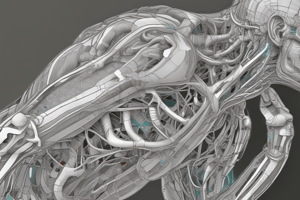Podcast
Questions and Answers
What is abduction?
What is abduction?
Moving a part away from the midline of the body
What is adduction?
What is adduction?
Moving a part toward the midline of the body
What is flexion?
What is flexion?
Bending a body part
What is extension?
What is extension?
What is hyperextension?
What is hyperextension?
What is rotation?
What is rotation?
What is circumduction?
What is circumduction?
What is pronation?
What is pronation?
What is supination?
What is supination?
What is opposition?
What is opposition?
What is inversion?
What is inversion?
What is eversion?
What is eversion?
What is dorsiflexion?
What is dorsiflexion?
What is plantar flexion?
What is plantar flexion?
What is radial deviation?
What is radial deviation?
What is ulnar deviation?
What is ulnar deviation?
Flashcards are hidden until you start studying
Study Notes
Range of Motion Terms
- Abduction involves moving a body part away from the central axis, crucial for limb mobility.
- Adduction is the opposite of abduction, bringing a body part closer to the midline, essential for stabilization.
- Flexion refers to bending a body part, reducing the angle between two segments, important for joint movement.
- Extension is the straightening of a body part, increasing the angle and restoring limb positioning.
- Hyperextension occurs when a body part is excessively straightened beyond its normal range, potentially leading to injury.
- Rotation involves turning a body part around its own axis, such as the head turning side to side, critical for directional movement.
- Circumduction is a circular movement at joints, incorporating flexion, extension, abduction, adduction, and rotation, evident in arm swings.
- Pronation describes the act of turning a body part downward, specifically the palm facing down, relevant in various hand functions.
- Supination is turning a body part upward, particularly with the palm facing up, important for certain grips and actions.
- Opposition enables the thumb to touch the tips of the fingers, a unique human feature allowing grasping and manipulation.
- Inversion involves turning a body part inward, particularly the foot, altering alignment and stability.
- Eversion is the opposite of inversion, turning a body part outward, contributing to balance and mobility.
- Dorsiflexion involves bending the foot backward towards the knee, crucial for activities like walking and running.
- Plantar flexion is the opposite movement, extending the foot away from the knee, important for push-off in walking.
- Radial deviation moves the wrist toward the thumb side, facilitating thumb movement and gripping.
- Ulnar deviation shifts the wrist toward the little finger side, impacting hand positioning and function.
Studying That Suits You
Use AI to generate personalized quizzes and flashcards to suit your learning preferences.




